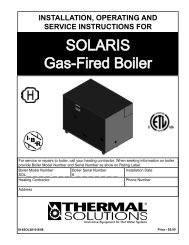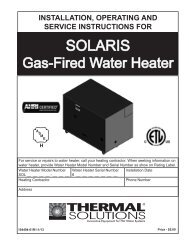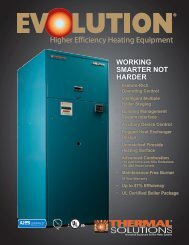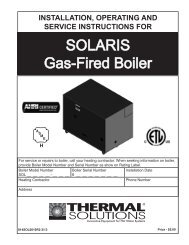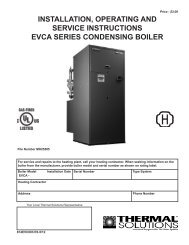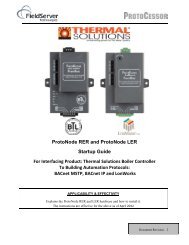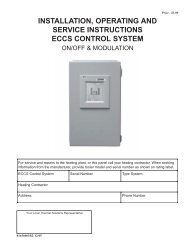installation, operating and service instructions eva series boiler
installation, operating and service instructions eva series boiler
installation, operating and service instructions eva series boiler
You also want an ePaper? Increase the reach of your titles
YUMPU automatically turns print PDFs into web optimized ePapers that Google loves.
I. Pre-Installation<br />
WARNING<br />
Carefully read all <strong>instructions</strong> before<br />
installing <strong>boiler</strong>. Failure to follow all<br />
<strong>instructions</strong> in proper order can cause<br />
personal injury or death.<br />
A. Installation must conform to the requirements of the<br />
authority having jurisdiction. In the absence of such<br />
requirements, <strong>installation</strong> must conform to the National<br />
Fuel Gas Code, NFPA 54/ANSI Z223.1, <strong>and</strong>/or<br />
CAN/CGA B149 Installation Codes. Where required<br />
by the authority having jurisdiction, the <strong>installation</strong><br />
must conform to the St<strong>and</strong>ard for Controls <strong>and</strong> Safety<br />
Devices for Automatically Fired Boilers, ANSI/ASME<br />
CSD-1.<br />
B. The <strong>boiler</strong> is not design certified for <strong>installation</strong> on<br />
combustible flooring. The <strong>boiler</strong> must not be installed<br />
on carpeting.<br />
C. Provide clearance between <strong>boiler</strong> jacket <strong>and</strong><br />
combustible material in accordance with local fire<br />
ordinance. Refer to page 4 of this manual for minimum<br />
listed clearance from combustible material.<br />
D. Install on level floor. For basement <strong>installation</strong> provide<br />
concrete base if floor is not perfectly level or if water<br />
may be encountered on floor around <strong>boiler</strong>. Floor<br />
must be able to support weight of <strong>boiler</strong>, water <strong>and</strong> all<br />
additional system components.<br />
E. Protect gas ignition system components from water<br />
(dripping, spraying, rain, etc.) during <strong>boiler</strong> operation<br />
<strong>and</strong> <strong>service</strong> (circulator replacement, condensate trap<br />
<strong>service</strong>, control replacement, etc.).<br />
F. Provide combustion <strong>and</strong> ventilation air in accordance<br />
with applicable provisions of local building codes<br />
or: USA - National Fuel Gas Code, NFPA 54/<br />
ANSI Z223.1, Section 5.3, Air for Combustion <strong>and</strong><br />
Ventilation; Canada - Natural Gas Installation Code,<br />
CAN/CGA - B149.1, or Propane Installation Code,<br />
CAN/CGA - B.149.2, Part 5, Venting Systems <strong>and</strong> Air<br />
Supply for Appliances.<br />
WARNING<br />
Adequate combustion <strong>and</strong> ventilation air<br />
must be provided to assure proper<br />
combustion.<br />
The following guideline is based on the National Fuel<br />
Gas Code, NFPA 54/ANSI Z223.1.<br />
1. Determine volume of space (<strong>boiler</strong> room). Rooms<br />
communicating directly with space (through<br />
openings not furnished with doors) are considered<br />
part of space.<br />
Volume [ft³] = Length [ft] x Width [ft] x Height [ft]<br />
2. Determine Total Input of all appliances in space.<br />
Round result to nearest 1,000 Btu per hour (Btuh).<br />
3. Determine type of space. Divide Volume by Total<br />
Input.<br />
a. If result is greater than or equal to 50 ft³ per<br />
1,000 Btuh, space is considered an unconfined<br />
space.<br />
b. If result is less than 50 ft³ per 1,000 Btuh, space<br />
is considered a confined space.<br />
4. Determine building type. A building of unusually<br />
tight construction has the following characteristics:<br />
a. Walls <strong>and</strong> ceiling exposed to outside atmosphere<br />
have a continuous water vapor retarder with a<br />
rating of 1 perm or less with openings gasketed<br />
<strong>and</strong> sealed, <strong>and</strong>;<br />
b. Weather-stripping has been added on openable<br />
windows <strong>and</strong> doors, <strong>and</strong>;<br />
c. Caulking or sealants applied in joints around<br />
window <strong>and</strong> door frames, between sole<br />
plates <strong>and</strong> floors, between wall-ceiling joints,<br />
between wall panels, at plumbing <strong>and</strong> electrical<br />
penetrations, <strong>and</strong> at other openings.<br />
5. For <strong>boiler</strong> located in an unconfined space in a<br />
building of other than unusually tight construction,<br />
adequate combustion <strong>and</strong> ventilation air is normally<br />
provided by fresh air infiltration through cracks<br />
around windows <strong>and</strong> doors.<br />
NOTICE<br />
Boilers operated with sealed combustion<br />
are exempt from needing provisions for<br />
combustion air from the room, provided air<br />
intake piping is installed per code <strong>and</strong> the<br />
<strong>instructions</strong> in this manual.<br />
6. For <strong>boiler</strong> located within unconfined space in<br />
building of unusually tight construction or within<br />
confined space, provide outdoor air through two<br />
permanent openings which communicate directly or<br />
by duct with the outdoors or spaces (crawl or attic)<br />
freely communicating with the outdoors. Locate one<br />
opening within 12 inches of top of space. Locate<br />
remaining opening within 12 inches of bottom of<br />
space. Minimum dimension of air opening is 3<br />
inches. Size each opening per the following:



